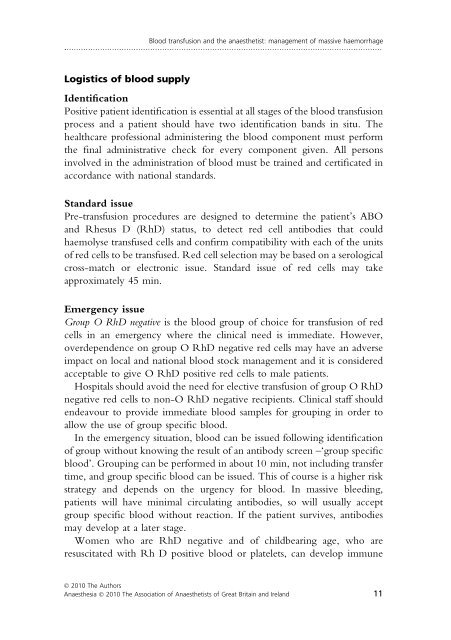Blood transfusion and the anaesthetist: management of ... - aagbi
Blood transfusion and the anaesthetist: management of ... - aagbi
Blood transfusion and the anaesthetist: management of ... - aagbi
Create successful ePaper yourself
Turn your PDF publications into a flip-book with our unique Google optimized e-Paper software.
<strong>Blood</strong> <strong>transfusion</strong> <strong>and</strong> <strong>the</strong> anaes<strong>the</strong>tist: <strong>management</strong> <strong>of</strong> massive haemorrhage<br />
.....................................................................................................................................<br />
Logistics <strong>of</strong> blood supply<br />
Identification<br />
Positive patient identification is essential at all stages <strong>of</strong> <strong>the</strong> blood <strong>transfusion</strong><br />
process <strong>and</strong> a patient should have two identification b<strong>and</strong>s in situ. The<br />
healthcare pr<strong>of</strong>essional administering <strong>the</strong> blood component must perform<br />
<strong>the</strong> final administrative check for every component given. All persons<br />
involved in <strong>the</strong> administration <strong>of</strong> blood must be trained <strong>and</strong> certificated in<br />
accordance with national st<strong>and</strong>ards.<br />
St<strong>and</strong>ard issue<br />
Pre-<strong>transfusion</strong> procedures are designed to determine <strong>the</strong> patient’s ABO<br />
<strong>and</strong> Rhesus D (RhD) status, to detect red cell antibodies that could<br />
haemolyse transfused cells <strong>and</strong> confirm compatibility with each <strong>of</strong> <strong>the</strong> units<br />
<strong>of</strong> red cells to be transfused. Red cell selection may be based on a serological<br />
cross-match or electronic issue. St<strong>and</strong>ard issue <strong>of</strong> red cells may take<br />
approximately 45 min.<br />
Emergency issue<br />
Group O RhD negative is <strong>the</strong> blood group <strong>of</strong> choice for <strong>transfusion</strong> <strong>of</strong> red<br />
cells in an emergency where <strong>the</strong> clinical need is immediate. However,<br />
overdependence on group O RhD negative red cells may have an adverse<br />
impact on local <strong>and</strong> national blood stock <strong>management</strong> <strong>and</strong> it is considered<br />
acceptable to give O RhD positive red cells to male patients.<br />
Hospitals should avoid <strong>the</strong> need for elective <strong>transfusion</strong> <strong>of</strong> group O RhD<br />
negative red cells to non-O RhD negative recipients. Clinical staff should<br />
endeavour to provide immediate blood samples for grouping in order to<br />
allow <strong>the</strong> use <strong>of</strong> group specific blood.<br />
In <strong>the</strong> emergency situation, blood can be issued following identification<br />
<strong>of</strong> group without knowing <strong>the</strong> result <strong>of</strong> an antibody screen –‘group specific<br />
blood’. Grouping can be performed in about 10 min, not including transfer<br />
time, <strong>and</strong> group specific blood can be issued. This <strong>of</strong> course is a higher risk<br />
strategy <strong>and</strong> depends on <strong>the</strong> urgency for blood. In massive bleeding,<br />
patients will have minimal circulating antibodies, so will usually accept<br />
group specific blood without reaction. If <strong>the</strong> patient survives, antibodies<br />
may develop at a later stage.<br />
Women who are RhD negative <strong>and</strong> <strong>of</strong> childbearing age, who are<br />
resuscitated with Rh D positive blood or platelets, can develop immune<br />
Ó 2010 The Authors<br />
Anaes<strong>the</strong>sia Ó 2010 The Association <strong>of</strong> Anaes<strong>the</strong>tists <strong>of</strong> Great Britain <strong>and</strong> Irel<strong>and</strong> 11

















